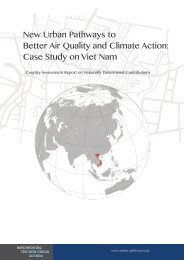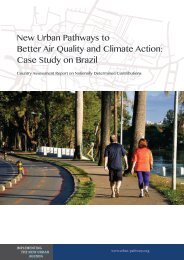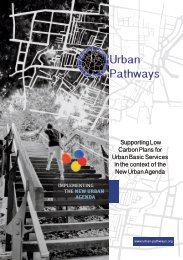Kenya
You also want an ePaper? Increase the reach of your titles
YUMPU automatically turns print PDFs into web optimized ePapers that Google loves.
New Urban Pathways to<br />
Better Air Quality and Climate Action:<br />
Case Study on <strong>Kenya</strong><br />
Country Assessment Report on Nationally Determined Contributions<br />
IMPLEMENTING<br />
THE NEW URBAN<br />
AGENDA<br />
www.urban-pathways.org
Authors/Contributors:<br />
Barbara Lah, Santhosh Kodukula<br />
Editor: Oliver Lah<br />
Layout/Design: Barbara Lah<br />
Photo: Copyright © CAIF 2017<br />
Abstract: This paper will help identifying policy measures in line with<br />
the New Urban Agenda and in the context of the respective Nationally<br />
Determined Contributions for <strong>Kenya</strong>. The paper will briefly assess<br />
framework conditions in the country in addition to policy actions<br />
with mitigation potential, with specific reference to<br />
energy and transport.<br />
<strong>Kenya</strong>’s Nationally<br />
Determined Contribution :<br />
Emission reduction of<br />
30% by 2030<br />
relative to BAU scenario,<br />
(baseline 2010)<br />
This project is part of the International Climate Initiative (IKI). The Federal<br />
Ministry for the Environment, Nature Conservation, Building and<br />
Nuclear Safety (BMUB) supports this initiative on the basis of a decision<br />
adopted by the German Bundestag.<br />
IMPLEMENTING<br />
THE NEW URBAN<br />
AGENDA<br />
www.urban-pathways.org
1. Summary of the Nationally Determined<br />
Contribution (NDC)<br />
<strong>Kenya</strong> is committed to reduce its GHG<br />
emissions by 30% by 2030, relative to a<br />
business-as-usual (BAU) scenario (baseline<br />
2010) of predicted 143 MtCO2e in 2030.<br />
Addressing climate change in a holistic manner<br />
will benefit <strong>Kenya</strong> to also address the<br />
other socio-economic challenges. By failing<br />
to address climate change in a multi-sectorial<br />
approach, <strong>Kenya</strong> will risk a further deterioration<br />
of the nation’s GDP, resulting in<br />
greater unemployment and worsening poverty.<br />
While, cities are gaining reputation of<br />
job centres, an increased focus is on the<br />
<strong>Kenya</strong>n government to introduce and improve<br />
the urban infrastructure. Building an<br />
efficient public transport system, securing<br />
a sustainable energy supply, investing in<br />
sustainable urban planning and mainstreaming<br />
the country´s effort with neighbouring<br />
still relatively low in comparison to other<br />
countries (73 MtCO2e in 2010) (Figure 1).<br />
Yet, carbon emissions started an increase<br />
from 1995 and this trend is likely to continue<br />
as <strong>Kenya</strong> strives to become a middle-income<br />
country by 2030 (<strong>Kenya</strong>´s National<br />
Action Plan, 2013).<br />
Figure 1: Business as Usual Scenario in <strong>Kenya</strong>,<br />
GHG Emissions between 2000-2030<br />
(NCCAP, 2012)<br />
An efficient public transport<br />
system will be essential to<br />
achieve the 1.5 degree target<br />
countries will be essential to achieve the<br />
1.5 degree target the global community has<br />
agreed on (UNFCCC, 2015).<br />
<strong>Kenya</strong>´s historical contribution of total global<br />
emissions per capita is low (less than 1.26<br />
MtCO2e) compared to the global average<br />
(of 7,58 MtCO2e). Emissions in <strong>Kenya</strong> are<br />
IMPLEMENTING<br />
THE NEW URBAN<br />
AGENDA<br />
www.urban-pathways.org
<strong>Kenya</strong>´s National Strategy aims to curb<br />
greenhouse gases such as carbon dioxide<br />
(CO2), methane (CH4) and nitrous oxide<br />
(N2O) in sectors such as, energy, transportation,<br />
industrial processes, agriculture, forestry<br />
and other land use and waste sector.<br />
Their planning process will include a review<br />
of the National Climate Change Action Plan<br />
(NCCAP) and the National Adaptation Plan<br />
(NAP) through the National Climate Change<br />
Secretariat (NCCS) every five years.<br />
Through the regular review process, the National<br />
Strategy also streamlines the climate<br />
change mechanism in all relevant ministries<br />
and will oversee the <strong>Kenya</strong>n Climate Fund.<br />
2. National Policies and Plans<br />
supporting the NDC target<br />
<strong>Kenya</strong> is committed to achieving its NDC<br />
targets based on existing laws and national<br />
policies. In recent years, <strong>Kenya</strong> has developed<br />
a National Climate Change Response<br />
Strategy (NCCRS 2010), a National Climate<br />
Change Action Plan (NCCAP 2013), a National<br />
Adaption Plan (NAP) and a Climate<br />
Change Act (2016) to curb the increased<br />
emissions in the country.<br />
Important official documents, which help<br />
contributing to the 1.5 Degree target:<br />
1. Constitution of <strong>Kenya</strong> (2010)<br />
2. Vision 2030 of the National Climate<br />
Change Action Plan (2013-2017) has been<br />
developed as a blueprint for flagship programmes<br />
and projects relating climate<br />
change adaptation and mitigation, including:<br />
• the Integrated National Transport Policy<br />
(2010),<br />
• the National Policy for the Sustainable<br />
Development of Northern <strong>Kenya</strong> and other<br />
<strong>Kenya</strong> wants to balance<br />
the need for economic<br />
growth with<br />
environmental protection<br />
Arid Lands,<br />
• the National Disaster Management<br />
Plan (2012)<br />
• the Environmental Management and<br />
Coordination Act (1999)<br />
• Water Act (2002)<br />
• the Energy Policy and Act<br />
(2004,2006,2012)<br />
• the Agricultural Sector Development<br />
Strategy 2010-2020<br />
• the <strong>Kenya</strong> Forestry Master Plan 1995-<br />
2020<br />
• the Second National Environment Action<br />
Plan (2009-2013)<br />
• Threshold 21 (T-21)<strong>Kenya</strong>, a dynamic,<br />
quantitative and transparent planning tool<br />
for climate adaptation.<br />
2.1 National Urban Policies<br />
Increasing population and migration to urban<br />
areas, due to growing economic and social<br />
segregation, threatens <strong>Kenya</strong>´s environment<br />
and liveability standards in cities, while<br />
also limiting access to basic urban services<br />
(GIZ, 2013). <strong>Kenya</strong>´s National Urban Policies<br />
have the potential to improve access to basic<br />
urban services through proper planning<br />
and design, e.g. through public spaces and<br />
public infrastructure development. Hence,<br />
IMPLEMENTING<br />
THE NEW URBAN<br />
AGENDA<br />
www.urban-pathways.org
promoting and improving the quality of life,<br />
while decreasing emissions nationwide.<br />
The task ahead of the <strong>Kenya</strong>n government<br />
is to trigger investments in infrastructure<br />
and services, balancing the need for economic<br />
growth without increased natural<br />
resource use. Increases in investments will<br />
contribute to a more balanced distribution<br />
of economic benefits and creates a framework<br />
for collaboration between local governments,<br />
the private sector and the public<br />
at large (UN-Habitat, 2014).<br />
The key elements of a green urban economy<br />
are – inclusive economic growth (reduce<br />
the gap between the rich and poor<br />
and increase social and economic participation),<br />
ecological compatibility (reducing<br />
greenhouse gas emissions by encouraging<br />
innovation and environmentally sound technologies),<br />
and poverty reduction (increasing<br />
income opportunities through improved<br />
access to jobs and to basic services) (GIZ,<br />
2013).<br />
policy and other measures necessary for<br />
climate change response and attaining low<br />
carbon climate change resilient development,<br />
administer the Climate Change Fund,<br />
set the targets for the regulation of greenhouse<br />
gas emissions, expand the renewable<br />
and clean energy options in the country, enhance<br />
resource efficiency and develop low<br />
carbon transport systems and a sustainable<br />
waste management.<br />
2.1.1 Energy<br />
<strong>Kenya</strong>´s plan for its energy security is the enhancement<br />
of its energy resilience through<br />
innovation and development of sustainable<br />
technologies. The National Energy Policy<br />
aims to increase the share of renewable energy<br />
sources (wind, biomass, small hydro,<br />
geothermal, biogas, solar and waste) (Ministry<br />
of Energy, 2012). <strong>Kenya</strong> generates power<br />
mainly from biofuel and waste, geothermal<br />
and solar, oil products, crude oil, coal<br />
Policy measures under consideration include<br />
the mainstreaming of climate change<br />
response into development planning, decision<br />
making and implementation, the formulation<br />
of programmes and plans to enhance<br />
the resilience, and adaptive capacity of humans<br />
and the ecological systems to the<br />
impact of climate change. <strong>Kenya</strong> will promote<br />
low carbon technologies to improve<br />
efficiency and reduce emissions intensity<br />
by facilitating approaches and uptake of<br />
technologies that support low carbon and<br />
climate resilient development. <strong>Kenya</strong>´s policy<br />
strategies are guidelines for the national<br />
and county governments on legislative,<br />
IMPLEMENTING<br />
THE NEW URBAN<br />
AGENDA<br />
www.urban-pathways.org
and hydro (IEA, 2014). At the moment only<br />
2.24 million people in <strong>Kenya</strong> have access<br />
to regular (grid based) power supply, most<br />
of which live in Nairobi. <strong>Kenya</strong> has two main<br />
energy suppliers, <strong>Kenya</strong> Power and KET-<br />
RACO. The government owns KETRACO<br />
entirely and owns 50.1% of <strong>Kenya</strong> Power.<br />
<strong>Kenya</strong> Power is also financed through commercial<br />
loans, paying annually 23 million<br />
USD in servicing debt.<br />
2.1.2 Transport<br />
<strong>Kenya</strong>´s main mode of transportation is<br />
road transport, accounting for 93% of<br />
freight and passenger traffic. The Agenda<br />
2030 has the goal to connect all regions of<br />
the country, primarily airports, railways and<br />
ports to enable economic activity. The north<br />
of the country is especially important as a<br />
connector to the neighbouring states, such<br />
as Democratic Republic of Congo, Rwanda,<br />
Burundi, Southern Sudan and Uganda.<br />
According to the ITF Transport Outlook<br />
2017, the infrastructure around centres, airports<br />
or production areas has to triple, to<br />
provide adeqate mobility (ITF, 2017). ITF<br />
predicts an increase in CO2 emission in<br />
Africa by 2050 from 2015 levels by almost<br />
three times, and <strong>Kenya</strong> has a key role in<br />
avoiding this increase.<br />
<strong>Kenya</strong>´s Vision 2030 foresees to promote<br />
mass transit systems to support the mobility<br />
of the high percentage of people who<br />
use non-motorised transportation. Shifting<br />
road freight to rail, water and non-moto<br />
rised transportation can reduce up to 4.1<br />
MtCO2 a year until 2030 (<strong>Kenya</strong>´s National<br />
Climate Change Action Plan, 2013). UNEP is<br />
working with the <strong>Kenya</strong>n government to implement<br />
a tax incentive scheme, increasing<br />
the share of cleaner vehicles, while banning<br />
old, emission intensive cars from <strong>Kenya</strong>´s<br />
roads (UNEP, 2014).<br />
3. <strong>Kenya</strong>´s Climate Change Action Plan<br />
The CC Action Plan will help delivering on<br />
several pressing issues in the country:<br />
Agriculture<br />
Agriculture is the largest GHG contributor<br />
in <strong>Kenya</strong> (30%), of which 90% come from<br />
Energy, trasport and<br />
resource management<br />
are identified as key<br />
climate change<br />
mitigation sectors.<br />
IMPLEMENTING<br />
THE NEW URBAN<br />
AGENDA<br />
www.urban-pathways.org
the livestock sector. This sector offers the<br />
potential to decrease emissions, while providing<br />
food security and reduction in climate<br />
vulnerability (DFID, 2012). Agroforestry will<br />
play a big part in the country’s future, potentially<br />
reducing 4.2 MtCOe by 2030 and curbing<br />
land erosion, while improving grazing<br />
conditions for livestock and increasing tree<br />
coverage on farms to 10% (DFID, 2012).<br />
Environment, Water and Sanitation<br />
Reforestation of degraded land will contribute<br />
to the target of clean water and sanitation<br />
access for all in <strong>Kenya</strong>, improving millions<br />
of livelihoods. Restoration of forests<br />
have the potential to reduce 20 MtCO2e<br />
annually by 2030, while sustainable waste<br />
management as well as tougher regulations<br />
on mining and mineral resources needs to<br />
be implemented.<br />
Tourism<br />
The tourism sector will rely heavily on<br />
the successful implementation of climate<br />
change mitigation, e.g. curbing ecosystem<br />
reduction, infectious diseases, high temperature.<br />
Infrastructure<br />
As <strong>Kenya</strong>´s economy grows, the more attention<br />
the physical infrastructure needs to<br />
attain, assuring a sustainable socio-economic<br />
development and attracting investment.<br />
Secure renewable energy (wind and solar<br />
needs to be expanded and transport infrastructure<br />
needs to be built and maintained,<br />
which in turn negatively impacts resource<br />
efficiency. Public transport needs to be introduced/expanded<br />
and existing private<br />
transportation properly regulated.<br />
Manufacturing<br />
Expanding the manufacturing sector will<br />
require increased water consumption, a resource<br />
already under pressure in dry seasons.<br />
Additionally, many cement manufacturers<br />
occasionally turn to burning coal as<br />
cheap fuel source, increasing GHG emissions<br />
countrywide. Awareness campaigns<br />
are planned to inform manufacturers and<br />
decision makers about the potential increased<br />
CO2 emissions.<br />
Population, Urbanisation and Housing<br />
Curbing climate change will help managing<br />
some of the reasons for urban migration<br />
from rural areas. Adaptation to climate<br />
change will include flood management in<br />
risk areas, slum upgrading and climate risk<br />
assessments for public buildings. Sustainable<br />
energy solutions for private households<br />
need to be introduced to reduce indoor<br />
pollution and save costs.<br />
Health<br />
Climate-sensitive diseases will rise when no<br />
action is taken. Adaptation measures will include:<br />
disease surveillance, early warning,<br />
monitoring and evaluation and systems for<br />
malaria epidemics.<br />
Disaster Preparedness<br />
Adaptation measures will include early warning<br />
systems in case of disaster, systems of<br />
effective response and the development of<br />
climate-proofed infrastructure.<br />
4. Conclusion<br />
<strong>Kenya</strong> has a commendable commitment to<br />
wards the environment and to reduce the<br />
IMPLEMENTING<br />
THE NEW URBAN<br />
AGENDA<br />
www.urban-pathways.org
effects of climate change. The obligation to<br />
protect the environment and the land is enshrined<br />
in the constitution of <strong>Kenya</strong>. <strong>Kenya</strong><br />
still has a long way to go and many difficult<br />
decisions to make to fulfil its commitment<br />
and reach its promised NDC target. Planned<br />
actions to deliver on these objectives include<br />
mainstreaming climate change into<br />
development planning, decision making and<br />
implementation; build resilience and enhancing<br />
adaptive capacity; provide incentives<br />
and obligations; promote low carbon technologies<br />
to improve efficiency and reduce<br />
emissions intensity; administer the Climate<br />
Change Fund; boost renewable and clean<br />
energy options; enhance resource efficiency;<br />
build low carbon transport systems; and<br />
provide sustainable waste management.<br />
5. References<br />
CarbonBrief, 2017, available at: https://www.carbonbrief.org/<br />
paris-2015-tracking-country-climate-pledges<br />
DFID, <strong>Kenya</strong>´s Climate Change Action Plan: Low Carbon Climate<br />
Resilient Development Pathway, 2012.<br />
GIZ, The Urban Future, Sixth Session of the World Urban Forum,<br />
2012.<br />
Government of <strong>Kenya</strong>, <strong>Kenya</strong>´s National Climate Change Action<br />
Plan, 2013-2017, Nairobi, 2012.<br />
Government of <strong>Kenya</strong>, <strong>Kenya</strong> National Climate Change Action<br />
Plan, 2013, available at: https://cdkn.org/wp-content/uploads/2013/03/<strong>Kenya</strong>-National-Climate-Change-Action-Plan.<br />
pdf<br />
Government of <strong>Kenya</strong>, National Climate Change Action Plan<br />
(NCCAP), Mitigation Analysis, Nairobi, 2012.<br />
IEA, Statistics for <strong>Kenya</strong>, available at: https://www.iea.org/<br />
statistics/statisticssearch/report/?year=2014&country=<strong>Kenya</strong>&product=Balances<br />
International Transport Forum, ITF Transport Outlook 2017,<br />
OECD Publishing, Paris, 2017.<br />
Ministry of Energy, Feed-In_Tariffs Policy on Wind, Biomass,<br />
Small-Hydro, Geothermal, Biogas and Solar Resource Generated<br />
Electricity, Nairobi, 2012.<br />
UNFCCC, Adoption of of the Paris Agreement, Paris, 2015.<br />
UN-Habitat, Urban planning for city leaders, Nairobi, 2014.<br />
United Nations, Sustainable Development in <strong>Kenya</strong>, Stocktaking<br />
in the run up to Rio+20, Nairobi, 2012<br />
UNEP, Annual Narrative Progress Report, Support to Low Carbon<br />
Climate Resilient Development for Poverty Reduction in<br />
<strong>Kenya</strong>, Nairobi, 2014.<br />
UN-Habitat is grateful for the financial support<br />
provided by the government of Norway for the<br />
NDC analysis this paper is based on.<br />
www.uemi.net<br />
www.wupperinst.org<br />
www.caif.eu<br />
www.wri.org<br />
IMPLEMENTING<br />
THE NEW URBAN<br />
AGENDA<br />
www.urban-pathways.org








